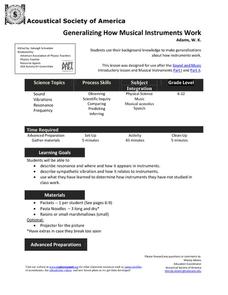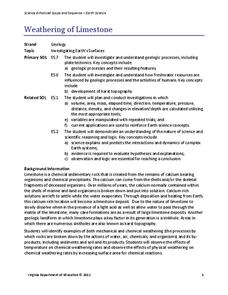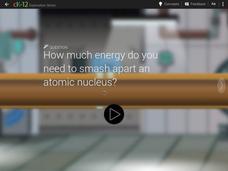Curated OER
What Are Physical and Chemical Properties?
In this properties worksheet, students compare and contrast physical properties and chemical properties. This worksheet is a graphic organizer.
Curated OER
Modern Physics, The Quantum
In this physics worksheet, students examine the relationship between the discrete and continuous spectrum alongside other concepts for the 9 questions.
Curated OER
Heat - A Form of Energy
Middle school or high school physical science pupils will warm up to the topic of heat when viewing this set of slides. It covers heat transfer, measurement tools, phase changes, and more. Have demonstrations and examples of the tools...
Curated OER
What on Earth is in the Earth?
Pupils explore the physical properties of sand, soil, and rocks and sort, classify, compare, and contrast the materials found in the soil. The differences between the living and non-living parts of the soil is discussed.
Curated OER
How Is A Frog Able To Swim In The Trees?
Fourth graders explore the interdependence of frogs and trees. They discuss the various things they need everyday to survive. Students select an animal from their local bioregion and research things that animal is dependent upon for...
Curated OER
The Case of Similar Substances
Students perform tests in the lab to identify an unknown substance. In this physical science lesson plan, students observe the physical and chemical properties of substances. They formulate a conclusion based on experimental results.
Curated OER
The Ups and Downs of Technology
Students create a visual timeline of skyscrapers built in the past 20 years. In this physical science lesson, students research important facts about the building. They discuss the challenges architects face when building skyscrapers.
Curated OER
The Real Eve
Students research about human migration during a specific time period. In this physical science instructional activity, students watch a video about human evolution. They prepare a presentation on human migration and share it with the...
Curated OER
What Is It?
Play the game of Tag and differentiate between plants and animals. Explore the characteristics of plants. Identify the major parts of plants (e.g., seeds, stem, pistil) and describe their basic functions. Compare the requirements of some...
Curated OER
What is the Attraction?
Second graders investigate the law of polarity. In this magnets lesson plan, 2nd graders discover how magnets are used in everyday life and which objects in our environment are magnetic. Students experiment with bar magnets and...
Curated OER
What is the Rocky shoreline?
Second graders access prior knowledge of the rocky shoreline. In this rocky shoreline lesson, 2nd graders create questions about the rocky shoreline. Students define vocabulary related to the rocky shoreline. Students...
Curated OER
What is a Gas?
Students develop a scientific model of gas behavior. For this gas lesson plan, students observe different balloons filled with different densities of gases. They complete an activity where they model the behavior of gases using marbles,...
Laboratory for Atmospheric and Space Physics
Jupiter’s Relative Size
How do you properly illustrate the extreme size difference between two planets—Earth and Jupiter? With the help of jellybeans, of course! Create a scale model of Jupiter's mass compared to Earth using a fishbowl, 1,400 beans, and a...
NASA
Photons in the Radiative Zone: Which Way Is Out? An A-Maz-ing Model
Can you move like a photon? Young scholars use a maze to reproduce the straight line motion of a photon. The second in a six-part series of lessons on the sun has learners measure angle of incidence and refraction to determine the path...
Acoustical Society of America
Generalizing How Musical Instruments Work
Sound, vibrations, resonance, and frequency are explored as learners use music to foster scientific inquiry. They engage in three different sound experiments and follow up discussions to foster a better understanding of how musical...
K12 Reader
Waves & Currents
Challenge your young readers with a passage about physical science. After reading about sound waves and electric currents, kids answer five reading comprehension questions about what they have read.
Virginia Department of Education
Weathering of Limestone
We all know limestone weathers, but what affects the rate of weathering? Young scientists investigate the physical and chemical weathering of limestone (chalk) through experimentation. First, they conduct trials with different-size...
Colorado State University
How Can I Turn a Solar Oven into a Refrigerator?
Whether you want to heat things up in science class or cool things down a bit, an intriguing lab's got you covered! Science scholars explore the principles of thermodynamics using a solar oven, then change the conditions to turn their...
K12 Reader
How Things Move
As part of a comprehension exercise, kids read a physical science article about motion and then answer a series of comprehension questions based on the passage.
Curated OER
What Can I Do?
Here is a good way for children to identify ways to handle conflict. They discuss the connection between feelings and conflict. Everyone listens to a story about a conflict between two friends and they discuss what they could have done...
CK-12 Foundation
High Energy Particles
How much energy is required to break apart an atomic nucleus and does it vary based on the type of atom? Scholars virtually experiment with a linear accelerator in order to answer these questions. They alter the voltage, length of the...
CK-12 Foundation
Lightning-Rod
Why do some buildings have lightning rods? Scholars explore the movement and attraction of opposing electrical charges through a simulation of a lightning rod. They control the cloud height, charge separation, and if the lightning rod is...
Colorado State University
Can it Really Rain Fish and Frogs?
You've heard of it raining cats and dogs ... but what about fish and frogs? It turns out, one scenario is much more likely than the other! Intrepid weather investigators examine the curious behavior of waterspouts using a leaf blower,...
Virginia Department of Education
Building a DNA Model
It has been decades since the discovery of DNA. Still, activities such building this DNA model allow blossoming scientists to better understand the components that form this overall structure. During this activity, they will also...























